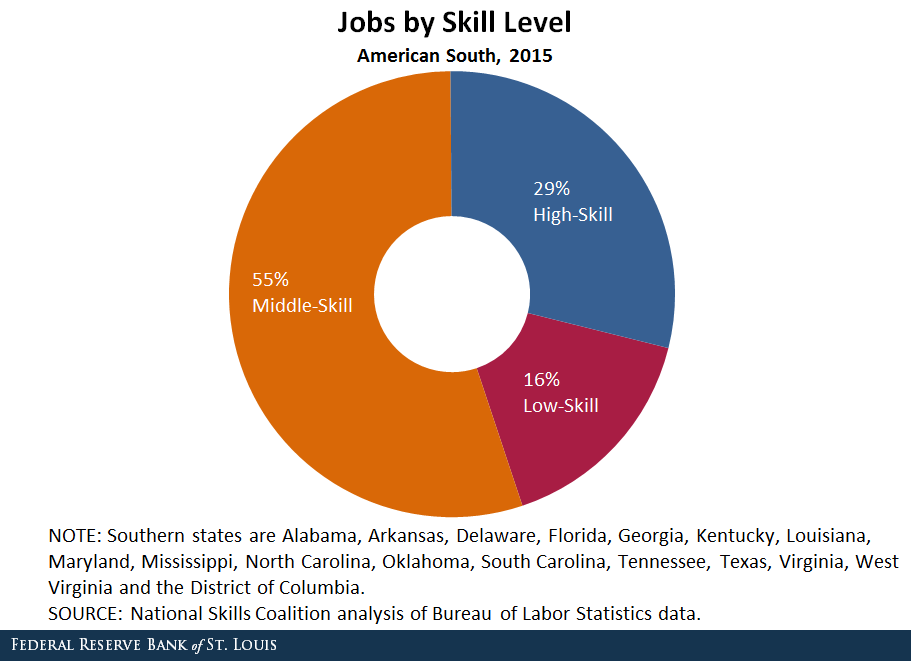Southern States Lacking Middle-Skilled Workers Risk Falling Behind

A recent report by the Federal Reserve Bank of St. Louis shows that Southern states are at risk of being left behind in this economic expansion if they don’t address a middle-skill workforce gap.For this report, Southern states are defined as Delaware, Florida, Georgia, Maryland, North Carolina, South Carolina, Virginia, West Virginia, Alabama, Kentucky, Mississippi, Tennessee, Arkansas, Louisiana, Oklahoma, Texas and the District of Columbia. Among those states, all of Arkansas and parts of Kentucky, Mississippi and Tennessee are in the St. Louis Fed’s District.
“Building a Skilled Workforce for a Stronger Southern Economy,” co-authored with the Federal Reserve Bank of Atlanta and the National Skills Coalition, finds that Southern states need to adapt to the new economy and invest in skill-building for adults to ensure that workers, families and businesses prosper.
Key takeaways of the report include:
- More than half of the jobs in the South are middle-skill positions—jobs that require education or training beyond high school but not a four-year college degree.
- If all of the South’s graduating high school students were to stay in the region and train for open jobs that require postsecondary education, there would still be unfilled positions.
- To close their skills gaps, Southern states must address people’s barriers to work.
Developing Skilled Workers Can Help Southern States Compete
The majority—55 percent—of all jobs in Southern states, along with the District of Columbia, are middle-skill positions, requiring education or training beyond high school but not necessarily a four-year college degree. And across the South, there are not enough workers trained to fill these jobs.
Stronger basic proficiency in math, teamwork, problem-solving, communicating and complex thinking are now necessary. This is true not just in jobs that require advanced degrees but also in the middle of the labor market, the report said. It also noted that many of these middle-skill jobs are “opportunity occupations,” paying at least the national median wage (roughly $37,000 per year in 2016) and requiring less than a four-year degree.

The middle-skill gap isn’t insurmountable, the report said, but Southern states need to educate more of the region’s adults to close the gap. Focusing on grade school students alone won’t be enough. “If each and every one of the South’s graduating high school students were to stay in the region and train for open jobs that require postsecondary education, there would still be unfilled positions,” the report noted.
This skills gap hurts businesses that are not able to fill positions, the report explained. It can also make it challenging for the states to attract and retain new businesses who are looking to relocate to areas that can meet their skill needs.
Tighter Labor Markets Underscore the Need to Address Barriers
While states are seeing record low unemployment rates among those who participate in the labor force, many states have also seen an increase in people who have been sidelined from the labor market.
To close their skills gaps, Southern states must address the barriers that are keeping people from working, the report said. The history, geography and policy decisions of the South have created barriers to working, including:
- Higher poverty rates
- Burdensome transportation costs
- Onerous child care costs
- High incarceration rates
- Restrictive policies for previously incarcerated people
The report added that these obstacles can be even more daunting in rural areas, where there may be additional challenges like limited job openings and limited broadband service.
To close their skill gaps, Southern states must provide opportunities for all adults—including people of color—to increase their education and training, the report noted. More than four in 10 Southerners are people of color, and estimates suggest that people of color will make up the majority of the U.S. population by 2044. “To create a skilled and thriving southern economy, state leaders must create an inclusive workforce,” the report said.
Case Study in the St. Louis Fed District
The report explained that education and training for middle-skill jobs can vary from short-term job training programs or two-year degree programs offered by community or technical colleges to apprenticeship or on-the-job training with an employer.
The report highlighted the Arkansas Career Pathways Initiative (CPI), which was formed in 2005 in response to Arkansas’ low number of residents with postsecondary credentials and relatively high poverty rate. (At 19 percent, it is higher than the nation’s average.)
Since its inception, the report noted, more than 30,000 students have enrolled in one of more than 400 career pathway options that link education, training and support services and lead to employment and career advancement in high-demand industries.
An external report found that around half of CPI participants between 2006 and 2013 received at least one postsecondary certificate or degree, compared to just a quarter of all Arkansas community college students. Moreover, CPI students of color were three times as likely to attain an academic credential, compared to their non-CPI counterparts.
Notes and References
1 For this report, Southern states are defined as Delaware, Florida, Georgia, Maryland, North Carolina, South Carolina, Virginia, West Virginia, Alabama, Kentucky, Mississippi, Tennessee, Arkansas, Louisiana, Oklahoma, Texas and the District of Columbia. Among those states, all of Arkansas and parts of Kentucky, Mississippi and Tennessee are in the St. Louis Fed’s District.
Additional Resources
Citation
ldquoSouthern States Lacking Middle-Skilled Workers Risk Falling Behind,rdquo St. Louis Fed On the Economy, Sept. 17, 2018.
This blog offers commentary, analysis and data from our economists and experts. Views expressed are not necessarily those of the St. Louis Fed or Federal Reserve System.
Email Us
All other blog-related questions

